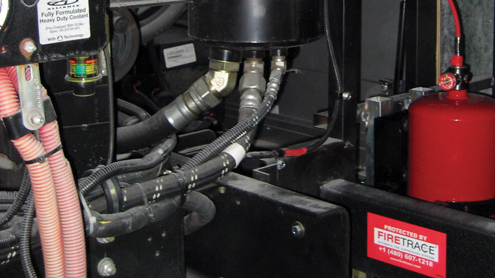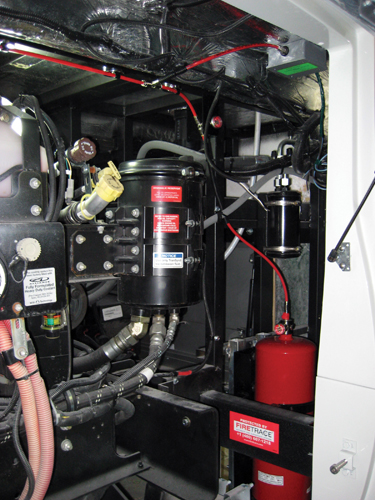
The statistics are forceful reminders of the prevalence of bus fires
By Angela Krcmar

Bus fires are far more prevalent than many in the industry are willing to admit. Nonetheless, getting everyone to talk more openly about the frequency of fire incidents can only lead to a safer traveling experience for all bus, motorcoach and school bus passengers.
According to 2006 study by the National Fire Protection Association (NFPA) and the National Fire Incident Reporting System (NIFRS), there are 2,210 bus or school bus fires on average reported each year. That amounts roughly to six fires a day, resulting on average in three deaths, 30 injuries and $24.2 million in property damage.
A recently completed three-year study by the Norwegian Public Road Administration concluded that as many as one in every hundred buses is involved in a fire incident each year. In 2004 Swedish insurance companies required that all insured buses be equipped with fire suppression, accounting for approximately 60 percent of the vehicles on the road. Since 2004, no complete burnouts of these buses have been reported, according to SP Technical Research Institute. This leaves the other 40 percent of self-insured or uninsured buses not protected by fire suppression and open to fire incidents.
The Volpe National Transportation Systems Center conducted a study on behalf of the Federal Motor Carrier Association (FMCSA) that put the number of reported motorcoach vehicle fires from 1995-2008 at 899, or roughly 160 per year. This compilation of data is based on its efforts to combine the varying sources of data to assist FMCSA in understanding the true hazards.
Recommended Practices
These statistics present a true concern and need for the inclusion of fire suppression in the bus industry. The American Public Transportation Association previously developed a recommended practice for the inclusion of fire suppression on fixed-route transit vehicles, but this does not include the recommendations for mobility, school buses or motorcoaches. These recommended practices are therefore open for interpretation and implementation, leaving it to municipalities to decide if fire suppression should or should not be included in their vehicle purchase.
The FMCSA has recommended legislation to include fire suppression on motorcoach vehicles, which it reintroduced this year.
At present, the SP Technical Research Institute of Sweden is working on a global standard that all countries can enforce to encourage the inclusion of fire suppression. SP has developed and proposed testing methods that will demonstrate the effectiveness of various agents available to the market in the best and worst case scenarios.
While the testing of the capabilities of the suppression agent to successfully extinguish a fire is important, the detection and activation methods are equally important factors that seem to have gone overlooked.
Causes of Bus Fires
A common thread among reported fire incidents point to engine and electrical malfunction. According to the NFPA study 59 percent of fire incidents were the result of mechanical failure or malfunction and 25 percent a result of electrical failure. According to the Volpe report, the engine compartment is the leading location of fire incidents followed by wheel wells.
The risks in the engine compartments include fuel line ruptures, other flammable liquids, debris and grease build up on the engine block, frayed or electrical wiring as well as heat from the turbocharger and exhaust are ignition points for many fires.
Allowing a fire to spread from the engine compartment and source of the fire creates a significant safety risk. The Volpe study says a fire in a motorcoach vehicle can fully engulf the vehicle in just 15 to 20 minutes. This leaves very little time between ignition and total loss of the vehicle forcing the passengers and operator to quickly exit a burning vehicle, increasing potential injury and weakening public opinion.
Steps to passenger protection
Fire suppression systems of every shape and size are available in the market place, but the key to successful suppression lies in the detection method. Dust, debris, temperature extremes, routine cleanings and most importantly, the airflow in a moving vehicle, all play a role in the ability of a suppression system to effectively detect a fire.
Consider these factors in the selection of a fire suppression solution:
Detection methods that can be routed throughout the engine compartment to target the areas of most concerns, particularly those having to do with airflow.
Detection not be affected by dust, debris and engine grime.
Automatic System activation that does not require power protecting a parked vehicle.
Ease of system installation on new or existing vehicles.
Immediate alert mechanism to the operator and passengers of a fire.
Angela Krcmar serves as Market Development Manager for Firetrace International, Scottsdale, AZ.
